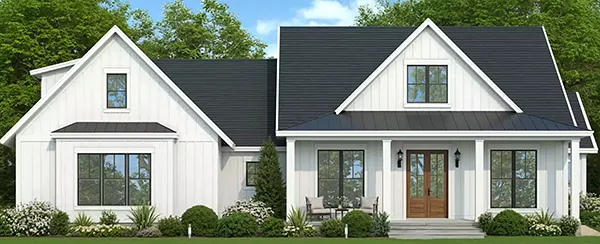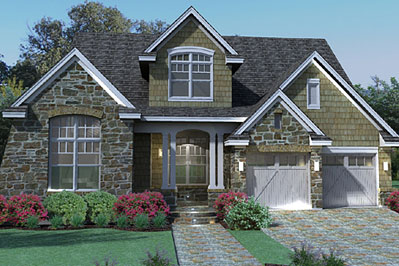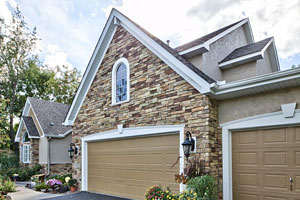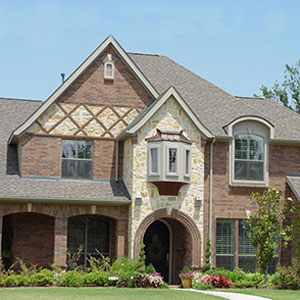Beautiful Stone Veneer and Brick
By Christine Cooney, The House Designers Staff Writer
Be the envy of your neighborhood! Give your home a fresh, stylish look by using beautiful stone veneer and brick siding.
Most new homes that appear to have a stone facade are actually stone veneer which is a manufactured stone that looks like real stone. Stone veneer has become very popular because it weigns less eliminating the need for wall ties or footings and makes it cheaper to install. It also costs less and is available in a variey of colors and designs making it easier to coordinate with the style and color or your new home. A quality veneer is also extremely durable, ensuring it will protect your structure with little maintenance giving your home lasting appeal.
Boral’s® manufactured
Cultured Stone® veneer is molded from natural stone producing an authentic, beautiful appearance. And don’t forget that manufactured stone is less expensive than real stone. When you factor in installation, you can save up to 30% on your entire stone project. Shown is a beautiful
two-story craftsman home featuring a mix of Cultured Stone
® and shingles.
With all the available shapes, styles and colors, you’re sure to find a product to match your home’s décor. For remodeling projects, stone veneer is very versatile and can easily be applied over concrete block, brick or stucco. Homes with wood siding simply require an additional thin layer of concrete upon which the veneer is applied.
You can create a striking, beautiful contrast by combining brick and stone. Brick endures longer than virtually any siding material and will maintain its beautiful look. Another benefit to brick is that it is more soundproof than other sidings to create a quiet and cozy interior. Check out one of our favorite house plans that combines brick and stone on it's facade.
If you’re performing a home renovation,
Cultured Stone® veneer can easily be applied over wood or stucco. The relatively simple upgrade adds tons of curb appeal and increases your resale vaue. This ranch home adds Ledgestone stone veneer accents to the garage and as a unique wall trim along the base of the home.
Another reason to consider using brick is that brick offers an average annual energy savings of 8%* more than traditional siding (*Building Industry Association). During hot days, brick slowly absorbs heat to inhibit the transfer of heat to your interior, keeping your home cooler. On cold days, brick will hold the sun's heat longer reducing the amount of energy needed to warm your home.
When selecting your brick or stone, natural or veneer, chose from reputable companies with quality products and excellent product guarantees like Boral Bricks and Cultured Stone. They offer an abundance of colors, styles and textures as well as specialty items like curved edges, detailed silhouettes and angled faces to customize your home and make your stone replicate the look of natural stone.
This two-story European home features Brandywine bricks from
Boral®. View the newest product releases from Boral
® Bricks by
clicking here.
How to Apply Stone Veneer Siding
Get the look of real stone without the high cost by following these easy step-by-step instructions:
Step 1: Create Your Design
First, create the pattern you want on your exterior by drawing it out on graph paper or using computer software if you have it. Next, lay the veneer stone on the ground in the pattern you have designed to ensure you have enough stones.
Step 2: Create a Moisture Barrier and Add a Wire Mesh
If you’re covering wood you’ll first need to create a moisture barrier by applying roofing felt or house wrap over the surface with nails. This step is not necessary for masonry walls. Attach a wire mesh to the wall with nails or screws. This will become part of the base that holds the stone veneer to the walls.
Step 3: Apply Mortar and Attach Stones
Once the wire mesh is attached, apply mortar approximately 1/16" to 1/8" thick with a trowel. Apply mortar to the stone and attach to the surface working in a horizontal pattern and leaving a small gap. Hold the stone against the surface until it sets. Be careful not to get mortar on the surface of the stone.
Step 4: Finishing Touches
Since laying stones is a bit like putting a puzzle together, not all the pieces will fit perfectly. Use a power saw with a masonry blade or grinder to reshape the stone to fit. Fill gaps and small spaces with grout to prevent moisture from getting through.



.png)
.png)




